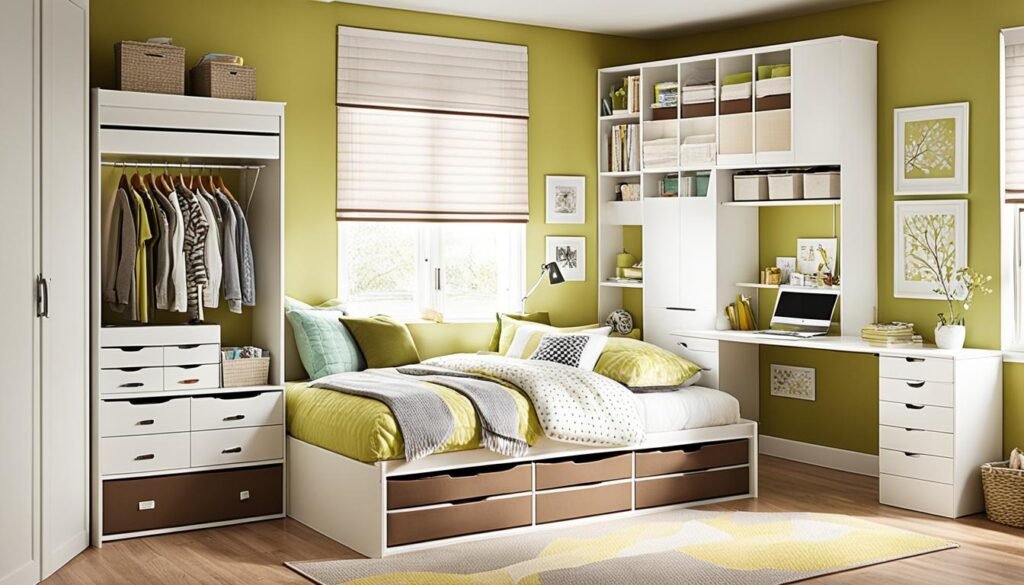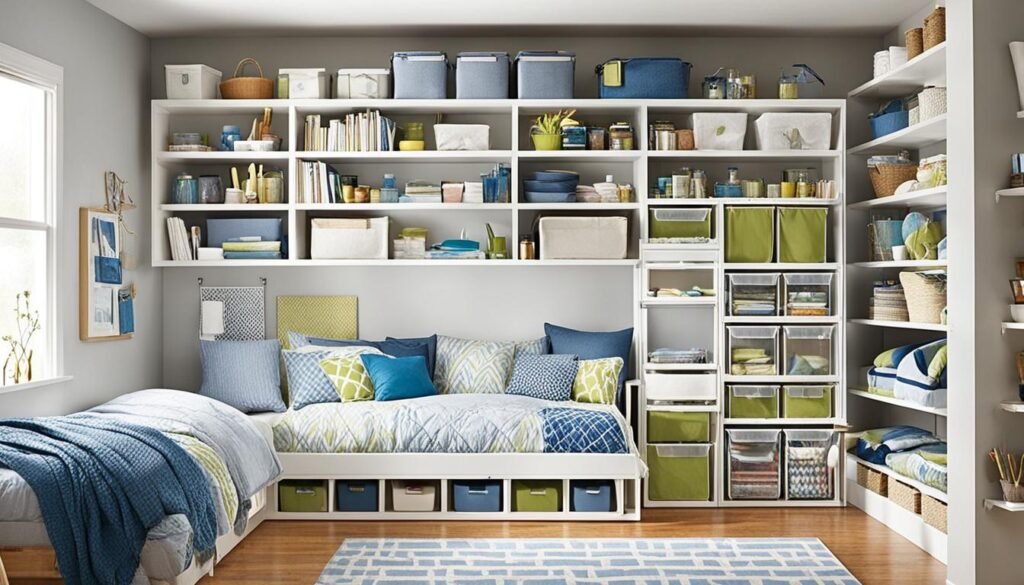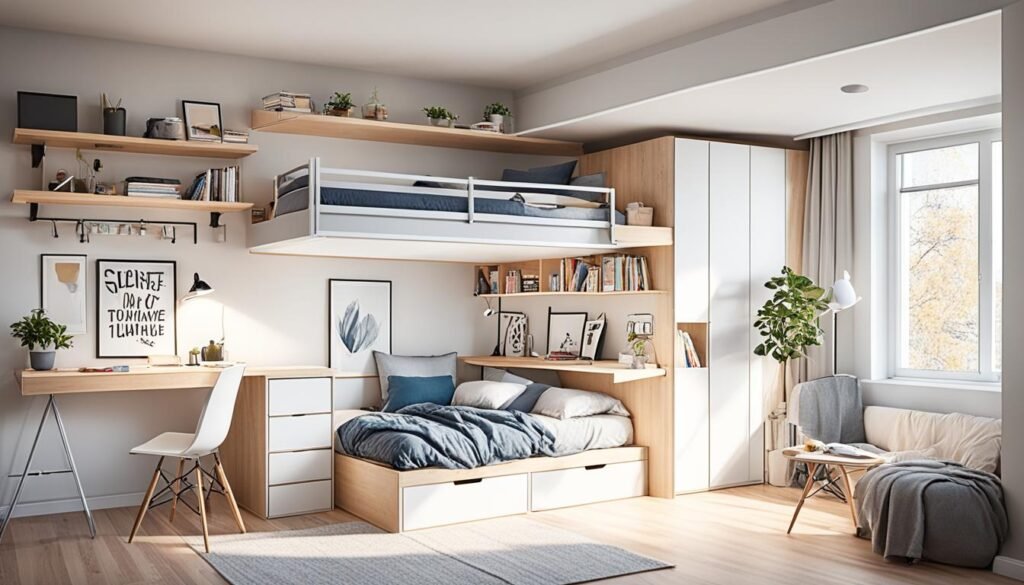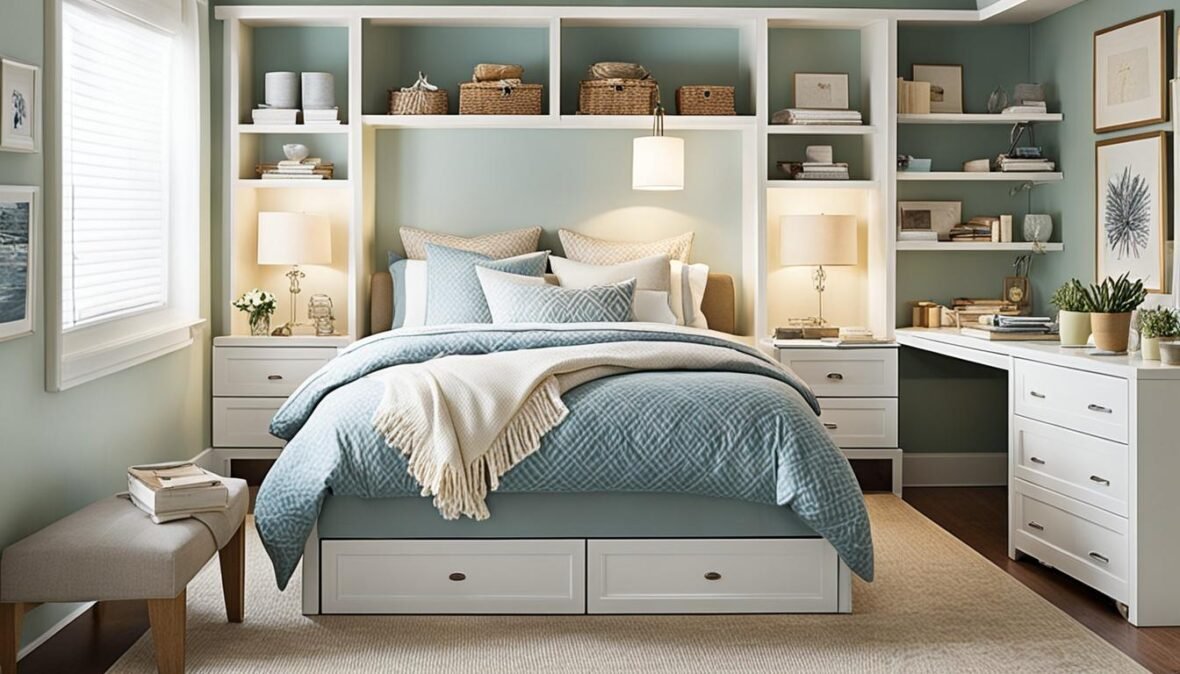Living in a small room can present unique challenges when it comes to organization. Limited space can quickly become cluttered and overwhelming if not properly managed. Thus small room organisation can be a daunting task.
However, with some thoughtful planning and creative solutions, you can optimize your small room to maximize its functionality and create a more organized and comfortable living space.
In this article, we will explore practical tips and ideas to help you maximize and optimize the organization of small rooms. Whether you have a tiny bedroom, a compact office, or a cozy living area, we have got you covered.

Organizing a small room can be a daunting task, but with the right strategies, you can create a space that is both functional and inviting. Whether you’re looking to declutter, maximize storage, or find clever space-saving solutions, our tips will help you make the most of your small space.
Key Takeaways:
- Decluttering is an essential first step to small room organization.
- Maximize storage by utilizing vertical space and investing in multi-functional furniture.
- Arrange furniture strategically to optimize space and flow.
- Discover clever space-saving solutions like wall-mounted organizers and under-bed storage.
- Use lighting and color strategies to create an illusion of space in small rooms.
Decluttering Techniques for Small Rooms
The first step in a small room organisaion is to declutter and prioritize your belongings. Start by going through your items and getting rid of anything you no longer need or use. This will help free up valuable space and make it easier to organize the remaining items.
Prioritize your belongings based on their importance and frequency of use. Keep the essentials within easy reach and consider storing less frequently used items in alternative storage solutions, such as under-bed storage or closet organizers.
1. Sort and Categorize
Start by sorting through your belongings and categorizing them into groups. This process can be overwhelming, so take it one area at a time. Create separate piles for items you want to keep, donate, sell, or discard. By organizing everything into distinct categories, you can better assess what you truly need and eliminate unnecessary clutter.
2. Let Go of Unused Items
Be ruthless in decluttering your small room. Let go of items that you no longer use or have sentimentally outgrown. Ask yourself if an object serves a purpose or brings you joy. If the answer is no, it’s time to say goodbye. Remember, freeing up space will make your room feel more open and inviting.
“A cluttered room is a cluttered mind. Clearing the chaos allows you to create a space that enhances productivity and promotes relaxation.” – [Expert Name]
3. Embrace Storage Solutions
Invest in storage solutions that are specifically designed for small rooms. Utilize space-saving furniture pieces with built-in compartments such as ottomans, bed frames with drawers, or wall-mounted shelves. Maximize under-bed and overhead storage, making use of every nook and cranny.
4. Utilize Vertical Space
Take advantage of vertical space to declutter your small room. Install floating shelves or hanging organizers on walls to store books, plants, or decorative items. This not only keeps your belongings off the floor but also adds visual interest to your space.
5. Create a Clutter-Free Daily Routine
Maintaining a clutter-free small room requires discipline and good habits. Dedicate a few minutes each day to tidy up and put things back in their designated places. This helps prevent clutter from accumulating and keeps your small room organized and inviting throughout the day.
Take a moment to visualize the transformation that decluttering can bring to your small room. By implementing these techniques, you can create a space that feels spacious, harmonious, and stress-free. Remember, a well-organized room not only enhances functionality but also allows your personal style and creativity to shine.
Maximizing Storage in Small Rooms
Limited space poses a unique challenge when it comes to organizing small rooms. However, with clever storage solutions, you can make the most of every inch and create a well-organized and functional space. In this section, we will explore creative ideas to maximize storage in small rooms.
Utilizing Vertical Space
One effective strategy for maximizing storage in small rooms is to utilize vertical space. Install floating shelves or wall-mounted cabinets to take advantage of unused wall areas. These vertical storage solutions not only provide extra space for displaying belongings but also draw the eyes upward, creating an illusion of a higher ceiling.
Consider using tall bookcases or adjustable shelving units that reach the ceiling. This not only provides ample storage for books, decorative items, or baskets but also adds an elegant touch to the room. Remember to keep the items you use frequently within easy reach and reserve the higher shelves for things you access less often.

Investing in Multi-functional Furniture
Another smart approach to maximizing storage in small rooms is to invest in multi-functional furniture. Look for items that serve more than one purpose, such as ottomans with hidden storage compartments, bed frames with built-in drawers, or coffee tables with shelving underneath.
Consider convertible furniture options like sofa beds or daybeds that can be used as seating during the day and transformed into a cozy sleeping space at night. These versatile pieces save valuable floor space and provide storage for bedding or pillows.
Organizing with Modular Storage Systems
Modular storage systems are a fantastic solution for small rooms where traditional furniture may not fit perfectly. These customizable and flexible systems allow you to create storage solutions tailored to your specific needs.
Choose modular storage units with various-sized compartments and drawers. This enables you to store different items neatly and efficiently, whether it’s clothes, shoes, accessories, or office supplies. Utilize baskets, bins, or storage boxes within the compartments to keep things organized and easily accessible.
Maximizing storage in small rooms is all about thinking vertically, investing in multi-functional furniture, and utilizing modular storage systems. These strategies will help you create a well-organized space that maximizes every inch.
| Storage Solution | Advantages |
|---|---|
| Floating shelves or wall-mounted cabinets | – Utilizes vertical space – Adds visual interest to the walls – Provides extra storage without taking up floor space |
| Tall bookcases or adjustable shelving units | – Maximizes vertical storage – Creates an illusion of higher ceilings – Adds an elegant touch to the room |
| Multi-functional furniture | – Saves space by serving multiple purposes – Provides hidden storage options – Maximizes functionality |
| Modular storage systems | – Customizable to fit specific needs – Offers flexibility in arranging compartments – Keeps items neatly organized |
Furniture Placement and Layout for Small Rooms
In small rooms, the placement and layout of furniture play a crucial role in optimizing space and creating a functional and visually pleasing environment. By strategically arranging your furniture, you can maximize every inch of your small room and enhance its overall flow and balance.
Tips and tricks for furniture placement
To help you make the most of your limited space, we have compiled a list of tips and tricks for furniture placement in small rooms:
- Measure your room: Before starting the furniture placement process, measure the dimensions of your room. This will allow you to accurately assess the available space and plan accordingly.
- Consider the focal point: Identify the focal point of the room, such as a fireplace or a large window, and arrange your furniture around it. This creates a sense of purpose and visual interest.
- Create a clear pathway: Ensure there is enough room to move around without obstruction. Leave sufficient space between furniture pieces to allow easy navigation and avoid a cramped feel.
- Utilize multi-functional furniture: In small rooms, it is essential to maximize functionality. Opt for furniture pieces that serve multiple purposes, such as storage ottomans or sofa beds.
- Experiment with different layouts: Don’t be afraid to try out different furniture arrangements until you find the one that best suits your needs and enhances the flow of the room.
- Utilize vertical space: When dealing with limited floor space, vertical storage solutions can be a game-changer. Consider using wall-mounted shelves or cabinets to free up valuable floor space.
In addition to these tips, it’s important to choose furniture pieces that are appropriately sized for your small room. Avoid bulky or oversized pieces that can overpower the space and make it feel cramped. Opt for sleek and compact designs that fit well within the room’s dimensions.
“The correct placement and layout of furniture can make a significant difference in the functionality and aesthetics of small rooms.”
By following these guidelines and getting creative with your furniture placement, you can transform your small room into a comfortable and harmonious space, perfect for both relaxing and entertaining.
Example Furniture Placement for a Small Bedroom:
| Item | Placement |
|---|---|
| Bed | Against the longest wall, preferably opposite the entrance |
| Nightstand | Next to the bed, on one or both sides |
| Dresser | Along one wall, perpendicular to the bed |
| Desk | Positioned near a window for natural light, if possible |
| Chair | Tucked into a corner or against a wall |
Clever Space-Saving Solutions
When space is limited in small rooms, it becomes crucial to discover innovative ways to maximize every corner. In this section, we will introduce you to a range of clever space-saving solutions that will help you transform your small room into a well-organized oasis.
Wall-Mounted Organizers

Make the most of your vertical space by utilizing wall-mounted organizers. These versatile storage solutions come in various styles and sizes, allowing you to hang them on the walls to store items such as books, magazines, keys, and even small plants. By keeping your belongings off the floor and countertops, you free up valuable space and create a clean and tidy environment.
Under-Bed Storage
Don’t underestimate the potential of the space under your bed. Invest in under-bed storage containers or drawers to store items that you don’t frequently use, such as seasonal clothing, spare linens, or shoes. This way, you utilize the often overlooked area and keep your essentials close at hand while maintaining a clutter-free room.
Utilizing the Backs of Doors
Make the most of the often underutilized backs of doors by adding hooks, racks, or storage pockets. This clever solution allows you to hang coats, bags, hats, and other accessories, freeing up valuable floor and closet space. Whether it’s in your bedroom, bathroom, or hallway, the backs of doors offer a practical storage opportunity that helps keep your small room organized.
“When it comes to maximizing space in small rooms, creativity is key. Utilize every available nook and cranny to create additional storage options and keep your belongings neatly organized.”
By implementing these clever space-saving solutions, you can make the most of your small room and create a clutter-free and functional space. Whether it’s utilizing wall-mounted organizers, under-bed storage, or the backs of doors, these strategies allow you to optimize the available space while maintaining a stylish and well-organized room.
Lighting and Color Strategies for Small Rooms
Lighting and color strategies are essential elements in creating the illusion of space in small rooms. By optimizing natural and artificial lighting, as well as exploring color techniques, you can make your small room feel brighter and more spacious.
Optimizing Lighting
Proper lighting is key to maximizing the perceived size of a small room. Consider incorporating the following lighting strategies:
- Maximize natural light: Remove heavy curtains or blinds and replace them with sheer options to allow natural light to enter the space.
- Strategic placement of artificial lighting: Install overhead lighting fixtures that distribute light evenly throughout the room. Supplement with task lighting for specific areas such as desks or reading nooks.
- Use mirrors: Hang mirrors opposite windows to reflect natural light and create an illusion of depth and openness.
Exploring Color Techniques
Choosing the right colors can visually expand the perceived size of a small room. Here are some effective color strategies:
- Opt for light and neutral tones: Lighter colors such as whites, creams, and pastels reflect more light, giving the impression of a larger space.
- Contrast with accents: Add pops of color through accessories and accent pieces to create visual interest and prevent the room from feeling monotonous.
- Utilize color gradients: Applying a gradient of colors, with the lighter shade towards the ceiling and the darker shade towards the floor, can create a sense of height.
By combining these lighting and color strategies, you can transform your small room into a brighter and more spacious area that feels airy and welcoming.
| Lighting Strategies | Color Strategies | |
|---|---|---|
| Maximize natural light | Remove heavy curtains or blinds and replace them with sheer options. | Opt for light and neutral tones such as whites, creams, and pastels. |
| Strategic placement of artificial lighting | Install overhead lighting fixtures that distribute light evenly throughout the room. Supplement with task lighting for specific areas. | Contrast with accents to create visual interest. |
| Use mirrors | Hang mirrors opposite windows to reflect natural light and create an illusion of depth and openness. | Utilize color gradients to create a sense of height. |
To further illustrate the impact of lighting and color strategies, let’s take a look at an example:
“After implementing lighting and colour techniques, my small bedroom went from feeling cramped and dull to bright and spacious. By maximizing natural light, removing heavy curtains, and using mirrors strategically, I was able to make the room feel much larger. Additionally, with the use of light and neutral colours on the walls and incorporation vibrant accents, the room now feels more vibrant and visually appealing. It’s amazing how a few simple changes can transform a small space!”- Emma, Small Room Organization Enthusiast
Now that you have learned about lighting and color strategies, you can apply these techniques to make the most of your small room and create an inviting and expansive ambiance.
Conclusion
In this article, we have shared our top tips and techniques for small room organization in cosy spaces. By implementing these ideas, you can transform cluttered and cramped rooms into functional and stylish havens.
Decluttering is the first crucial step in creating an organized small room. Sort and categorize your belongings, letting go of items you no longer need. Maximize storage by utilizing vertical space, investing in multi-functional furniture, and incorporating modular storage systems.
Strategic furniture placement and layout can optimize the available space, creating visual balance and enhancing the flow of the room. Explore clever space-saving solutions, such as wall-mounted organizers and under-bed storage, to maximize every corner.
Lighting and color also play significant roles in small room organization. Optimize natural and artificial lighting to create a brighter and more spacious feel. Additionally, utilize color strategies that visually expand the perceived size of your small room.
Embrace the potential of your small space and create an organized sanctuary that reflects your unique style and personality. With these tips and techniques, you can transform your small room into a well-organized oasis.

Follow Me